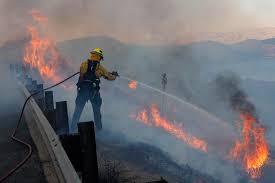Wildfire smoke is fast becoming one of the most significant environmental health threats in North America, as massive blazes across the United States and Canada continue to send thick plumes of smoke over vast distances. Experts warn that these events are undermining years of progress achieved through stringent air-quality regulations and emissions control policies.
Millions Exposed to Dangerous Air
In recent weeks, millions of residents have been exposed to dangerous levels of fine particulate matter (PM2.5) — microscopic particles produced by burning vegetation that can deeply penetrate the lungs and enter the bloodstream. Even cities hundreds of kilometers from active fire zones, including parts of the U.S. Midwest and East Coast, have recorded unhealthy air quality index (AQI) readings and reported hazy skies reminiscent of major pollution episodes in industrial regions.
Local authorities have issued health advisories urging people to limit outdoor activity, use air purifiers indoors, and wear masks to reduce exposure. Several schools temporarily suspended outdoor programs, while hospitals in affected regions reported rising cases of respiratory distress and cardiovascular complications among vulnerable populations, including children, the elderly, and those with preexisting lung conditions.
Climate Change and Fire Intensity Fuel the Crisis
Environmental scientists attribute the worsening smoke problem to climate change-driven factors such as prolonged droughts, rising temperatures, and poor land management practices. These conditions have created longer, more intense wildfire seasons across western North America, resulting in unpredictable transboundary smoke events that defy traditional pollution control strategies.
Unlike factory or vehicle emissions, wildfire smoke moves erratically with wind patterns, spreading across states and even national borders. “We’re entering a new era of air pollution,” said one environmental health expert. “This is no longer a local wildfire issue — it’s a continental public health and climate crisis.”
Calls for Policy and Preparedness Reform
Researchers and environmental agencies are urging cross-border collaboration between the U.S. and Canada to improve wildfire forecasting, emergency response, and air-quality monitoring. Experts emphasize that mitigation efforts must go beyond firefighting and include climate adaptation and forest management reforms to address the root causes of the crisis.
Despite decades of success in reducing smog and industrial pollution under laws like the U.S. Clean Air Act, scientists warn that unchecked wildfires could undo much of this progress. As smoke continues to blanket large regions, officials stress that long-term solutions — including emission cuts, sustainable forestry, and urban air resilience planning — are essential to protect both the environment and public health.
A Continent on Alert
With each passing year, the threat of wildfire smoke grows more severe. Experts caution that without decisive climate action, smoke-filled skies could become a regular summer phenomenon across North America, reshaping how cities, healthcare systems, and communities confront the realities of a warming planet.

